
As October ended yesterday, I thought I’d check your memory and your knowledge of Tudor history events that took place in the month of October.
Good luck!
And don’t forget, you can find all the answers on the Tudor Society website!
[Read More...]
As October ended yesterday, I thought I’d check your memory and your knowledge of Tudor history events that took place in the month of October.
Good luck!
And don’t forget, you can find all the answers on the Tudor Society website!
[Read More...]
Dr Emma Levitt shows us some amazing primary sources to unravel the spectacle of the tournament that Henry VIII would have enjoyed.
[Read More...]
On this day in Tudor history, 31st October 1537, Lord Thomas Howard, second son of Thomas Howard, 2nd Duke of Norfolk, died while imprisoned in the Tower of London. He was about twenty-five years of age at his death.
How did this son of the 2nd Duke of Norfolk and brother of the 3rd Duke of Norfolk end up dying in the Tower?
Well, he fell in love with the wrong woman? He had become secretly betrothed to King Henry VIII’s niece, Lady Margaret Douglas.
Find out more about Lord Thomas Howard, his relationship with Lady Margaret Douglas, and what happened to them both, in today’s talk. Oh, and Margaret really didn’t learn her lesson!
[Read More...]
On this day in Tudor history, 30th October 1600, Queen Elizabeth I refused to renew Robert Devereux, 2nd Earl of Essex’s monopoly on sweet wines, saying that “an unruly horse must be abated of his provender, that he may be the easier and better managed.”
It may not sound like a major event, but it was for Essex and it drove him to desperation and, ultimately, to the scaffold.
Why? What was going on? How could the queen’s refusal to renew this monopoly lead to Essex’s undoing?
Find out what was happened in 1600 and what happened next with the queen and her favourite, in today’s talk.
[Read More...]As this weekend is Hallowtide, I thought I’d explore the topic of ghosts and look at what medieval and Tudor people thought about them.
[Read More...]
On this day in Tudor history, 29th October 1532, King Henry VIII bid farewell to his “loving brother”, his French counterpart, King Francis I.
The two kings had enjoyed each other’s company at Calais and Boulogne, and Henry VIII was pleased with their meetings. In fact, things had gone so well that Henry VIII decided to marry Anne Boleyn!
Find out more about their farewell, and what had happened during the trip, in today’s talk.
[Read More...]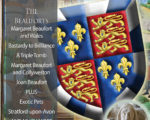
In this month’s magazine, we look at the Beauforts and their influence and lasting effect on our favourite era
[Read More...]
We had a wonderful live chat with author Caroline Angus at the weekend. The subject was Thomas Cromwell, a man who really divides opinion. Here’s a transcript of the chat, which included some excellent questions and answers, for those of you who missed it.
[Read More...]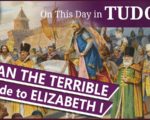
On this day in Tudor history, 28th October 1570, Ivan IV of Russia, known commonly as Ivan the Terrible, wrote a rather rude letter to Queen Elizabeth I.
Ivan was upset with Elizabeth’s reaction to his idea of a political alliance, an agreement to help each other if their lives were in danger, and wrote the letter while he was still angry. They were words that must have made Elizabeth see red for a while, but she managed to write a calm reply to him.
Find out exactly what Ivan the Terrible and Elizabeth I wrote to each other, and how they came to be corresponding in the first place, in today’s talk.
[Read More...]
On this day in Tudor history, 27th October 1561, Mary Herbert (née Sidney), Countess of Pembroke, writer and literary patron, was born at Tickenhall, near Bewdley in Worcestershire. She was the sister of the poets Sir Philip Sidney and Robert Sidney, Earl of Leicester, was a writer herself and an extremely talented lady, and she also lived life to the full.
After her husband died, she had fun shooting pistols, flirting, taking tobacco and dancing. A fun lady!
Find out more about this gifted Tudor woman, who was as beautiful as she was talented, and whose work was praised, and used, by men such as Shakespeare.
[Read More...]
On this day in Tudor history, 26th October 1536, the rebels of the Pilgrimage of Grace halted at Scawsby Leys near Doncaster, where they met crown troops. The rebels were said to number around 30,000 and the crown’s army was only a fifth of the size, but the rebel leader, lawyer Robert Aske, chose to negotiate rather than fight.
Why, when they could well have won?
Well one Tudor chronicler puts it down to rain. You can find out more about this meeting, how rain put a stop to the rebels’ plans, and what happened next between the Pilgrimage of Grace rebels and Henry VIII, in today’s talk.
[Read More...]
Today, 25th October, is a feast day which was celebrated in medieval and Tudor times – the feast of Saints Crispin and Crispinian, martyrs of the Early Church and the patron saints of cobblers.
Find out more about these saints, how their feast day became linked to an important English victory over the French, how it was marked, and why these saints are linked to Faversham in Kent, in today’s talk.
[Read More...]
How much do you know about the ships used in Tudor naval battles and by Tudor navigators and explorers?
Test your knowledge with this fun wordsearch and remember, the words can go in any direction. Simply click on the link or image below to open and print out.
[Read More...]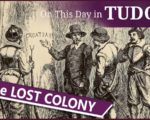
On this day in Tudor history, 24th October 1590, John White, the governor of the Roanoke Colony, returned to England after failing to find the lost colonists, which included his daughter, Ellinor (Elenora), his son-in-law, Ananias Dare, and his granddaughter, Virginia Dare.
But what happened to these colonists and what did the word CROATOAN carved onto a post mean?
Find out all about the Roanoke Colony and the theories regarding the disappearance of all 115 people, including the very latest research, in today’s talk.
[Read More...]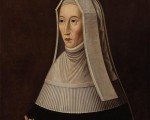
I find Lady Margaret Beaufort fascinating and it’s so frustrating and annoying for me to see her being badly maligned on social media the way she is. Let’s celebrate the real Lady Margaret Beaufort with some resources on her.
[Read More...]
On this day in Tudor history, 23rd October 1538, Thomas Goldwell, Prior of Christchurch, Canterbury, wrote to Thomas Cromwell, Henry VIII’s chief advisor, regarding the forthcoming dissolution of his monastery and its fate.
It’s quite a sad, grovelling letter, and even more sad when you know the full impact of Henry VIII’s dissolution of the monasteries, which was devastating for his country.
Find out more about Goldwell’s priory and what happened to it, as well as what the dissolution entailed, in today’s talk.
[Read More...]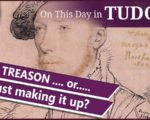
On this day in Tudor history, 22nd October 1537, an examination, or rather interrogation, was carried out regarding an accusation of treasonous words spoken against King Henry VIII.
Further investigations into the matter found that there was no evidence that these words were spoken, and that someone was trying to get another person into trouble.
What was going on? In a time when the punishment for high treason was death, this was very serious.
Find out more about what happened in this talk
[Read More...]
On this day in Tudor history, 21st October 1536, during the Pilgrimage of Grace rebellion, Lancaster Herald had an encounter with armed peasants on his way to Pontefract Castle and then met with rebel leader, Robert Aske, at the castle. The meeting didn’t go well, with Aske putting his foot down and not allowing the herald to complete his mission.
What was going on? Who was Lancaster Herald? What was his mission?
Find out more about the situation at Pontefract in today’s talk.
[Read More...]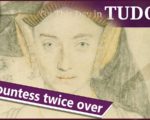
On this day in Tudor history, 20th October 1557, or possibly 21st, courtier Mary Arundell died at Bath Place in London.
Mary is an interesting Tudor lady. Not only did she serve at least two of Henry VIII’s wives, but she was a countess twice over, having been married to both the Earls of Sussex and Arundel. She has also been confused with two other Tudor ladies, and we don’t know whether the portrait you see in the thumbnail is really her.
Find out more about Mary Arundell’s life, court career and those of her husbands, in today’s talk.
[Read More...]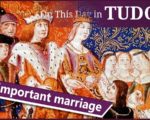
On this day in history, 19th October 1469, an event took place in Spain that was not only important in Spanish history, but which had an impact on Europe and which has links with the Tudors.
The event was the marriage of an eighteen-year-old woman called Isabella and a seventeen-year-old man called Ferdinand. They’d become the famous Reyes Catolicos, the Catholic monarchs, Isabella I of Castile and Ferdinand II of Aragon, and would bring together two powerful kingdoms, which comprised most of what is modern-day Spain.
In today’s talk, I tell you more about this powerful couple, their reigns and their legacy.
[Read More...]
On this day in Tudor history, 18th October 1555, Elizabeth, daughter of Henry VIII and Anne Boleyn, finally received permission from her half-sister, Queen Mary I, to leave court and travel to her own estate at Hatfield, rather than return to house arrest in Woodstock.
Poor Elizabeth had spent the last 18 months being watched or imprisoned, so this must have been a huge relief.
But why had Elizabeth been watched and confined? What had she gone through and why?
Find out more about this awful part of Elizabeth I’s life in today’s talk.
[Read More...]
We are so very blessed here at the Tudor Society to have so many wonderful experts contributing articles to Tudor Life magazine and speaking to us on a range of Tudor topics and people, as well has allowing us to grill them in live chat sessions.
We’re celebrating their input today with this fun crossword puzzle. Apologies to those not mentioned!
Simply click on the link or image below to open the crossword puzzle and print out.
[Read More...]
On this day in history, 17th October 1560, spy and Protestant martyr, Walter Marsh was baptised at St Stephen’s Church in London.
Marsh came to a sticky end, being burned to death in Rome’s Campo dei Fiori after having his tongue cut out, his hand cut off and being tortured with burning torches. He had been accused of being paid by Queen Elizabeth I to spy on Catholics and of showing contempt for the Eucharist.
Find out more about Walter Marsh, how he’d come to be in Rome and what he’d done to upset the authorities, in today’s talk.
[Read More...]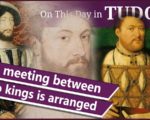
On this day in Tudor history, 16th October 1532, while Henry VIII and Anne Boleyn, Marquess of Pembroke, were on their visit to Calais, English nobles met French nobles to arrange a meeting between the King of England and his French counterpart, King Francis I.
In today’s talk, I give details on this event, who was there, what happened, and why Henry VIII and Anne Boleyn had gone to Calais.
[Read More...]
On this day in Tudor history, 15th October 1584, schoolteacher and poet Richard White was hanged, drawn and quartered for high treason at Wrexham in Wales due to his Catholic faith.
Find out about Richard Gwyn’s life, how an attack by crows and kites made him steadfast in his faith, his arrest and downfall, his works, and the legends associated with his death, in today’s talk.
[Read More...]
In our brand-new feature, Julian Humphrys will be sharing information about battles, warfare and castles. This video takes us to Deal Castle in Kent, a fortification which did its job as it never saw much action!
[Read More...]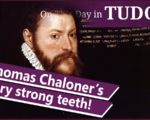
On this day in Tudor history, 14th October 1565, diplomat and poet, Sir Thomas Chaloner the Elder, died at his home in Clerkenwell, London. He was just forty-four years old. He’d served four Tudor monarchs as a diplomat, but he also wrote English and Latin works.
Find out more about Thomas Chaloner, his life, his career, and how his teeth saved him from death, in today’s talk.
[Read More...]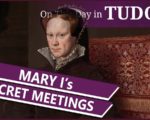
On this day in Tudor history, 13th October 1553, Queen Mary I wrote a very interesting letter to the imperial ambassador, Simon Renard. In it, she asked the ambassador to meet with her secretly, and she’d encouraged him previously to come to her secretly and in disguise.
Why? What was going on? And why did Mary seem to trust the emperor and his ambassadors more than her own council?
Find out more about the situation in today’s talk.
[Read More...]
On this day in Tudor history, 12th October 1555, Lewis Owen, member of Parliament and administrator in Wales, was assassinated on Dugoed Mawddwy, a mountain pass.
Owen was murdered by a group of bandits as revenge for his campaign against them, which had led to around 80 hangings.
Find out more about Lewis Owen, his life and what happened, in today’s talk.
[Read More...]
On this day in Tudor history, 11th October 1532, King Henry VIII and Anne Boleyn, the newly created Marquess of Pembroke, set sail from Dover aboard the king’s ship, The Swallow.
They were off to Calais on a mission involving the Great Matter, Henry VIII’s quest for an annulment. But why? What would they do there? Who would they meet?
Find out more about this trip, what happened and what happened next, in today’s talk.
[Read More...]